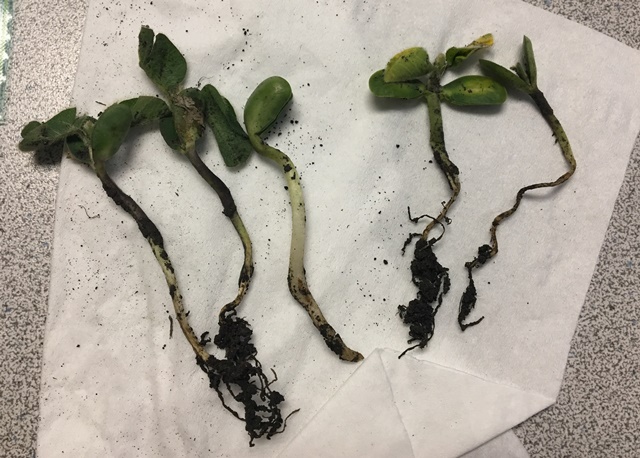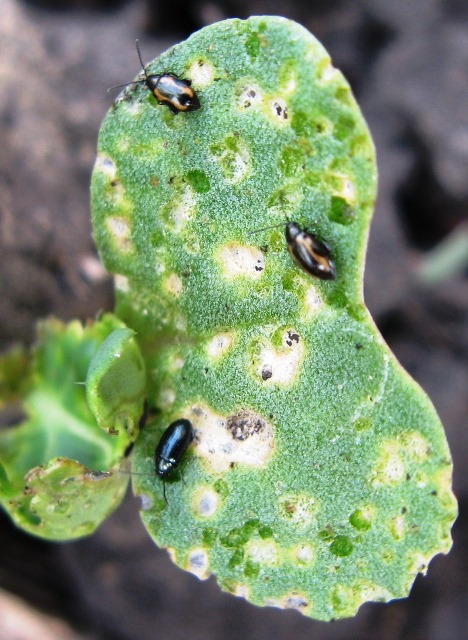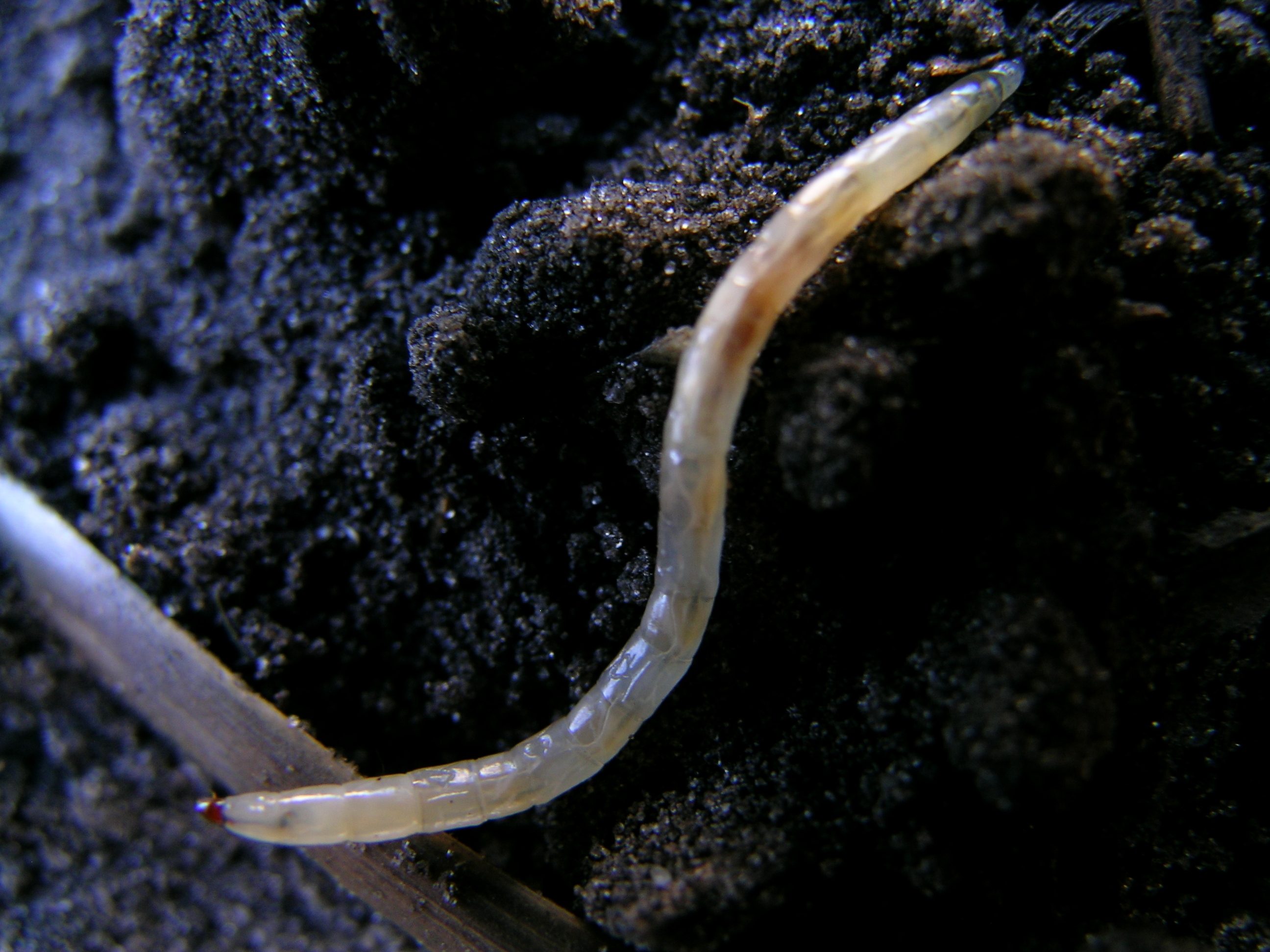Manitoba Insect & Disease Update
Issue 1: May 30, 2018
Summary
Diseases: Seedling disease is showing up in early planted soybeans.
Insects: Flea beetles are a concern in many canola fields and foliar insecticide applications are occurring in many areas. There has also been some reseeding of canola because of flea beetle feeding. Cutworms are being found in some fields. Currently most have not been at economic levels, however there have been insecticide application for cutworm in a few fields. Dingy and redbacked cutworm appear to be the dominant species in some of these fields.
Seedling Disease in Soybeans
Early seeded soybeans are emerged or beginning to emerge and some fields are showing signs of seedling disease. The image below depicts both healthy and diseased seedlings. Pinching of the stem at the soil line and a reduction in root growth and general plant vigour were observed in the diseased seedlings (pictured on the right). Seedling disease in soybeans can be caused by a number of different organisms including Fusarium spp., Pythium spp., Rhizoctonia solani, and others. These samples have been submitted to the Crop Diagnostic Lab for diagnosis, but Fusarium spp. seem the most likely suspect as soil compaction and drought favour seedling disease and root rot caused by this genus. Seed treatments help protect against seedling disease in soybeans, but delayed emergence due to the dry conditions can result in reduced protection from the seed treatment before plants have grown out of the seedling stage.

Figure 1. Healthy soybean seedlings (left) versus seedlings showing signs of seedling disease (right).
Flea Beetles in Canola
Warm, calm days are ideal for flea beetle feeding, and this is generally the time of year when populations start to peak. Canola that was seeded at least 3 weeks ago and does not have at least 3 or 4 true leaves should be assessed for flea beetle feeding.
Threshold: Some pitting is normal, even if the seed treatments are still at levels that kill flea beetles. The flea beetles need to consume a small amount of tissue to be killed. As a guideline, when about 25% of the surface area of the cotyledons and true leaves have been damaged, and flea beetles are present, an insecticide would likely be economical.
Consider the crop stage: Once the third and fourth true leaves are expanded, the canola will likely be able to compensate for any remaining flea beetle feeding.
Weather considerations: Flea beetles feed most actively on canola when the weather is sunny, warm, and dry. Cool damp weather reduces the intensity of feeding and aids plant growth.
Remember that if using a pyrethroid insecticide for flea beetle control that this group of chemistry has temperature restriction - check the labels or the Guide to Crop Protection.

Figure 2. Striped flea beetles (upper two) and crucifer flea beetle (lower beetle) and feeding pits on canola.
Insect Monitoring Programs
Diamondback Moth: Monitoring adults of diamondback moth with pheromone baited traps has been underway since the beginning of May. Overall counts have been low. Until May 20th the highest cumulative counts had been 2. During the week of May 20-26 a few higher counts occurred in the Central and Interlake regions, signifying a small population may have blown into the regions. But levels are still low . Table 1 below summarizes the highest cumulative counts in Manitoba.
Table 1. Highest cumulative trap counts for diamondback moth adults over the trapping period April 29 to May 29, 2018.
| Location | Count |
|---|---|
| Oak Bluff | 36 |
| Warren | 35 |
| Balmoral | 29 |
| Teulon | 14 |
| Rosenort | 8 |
| Petersfield | 7 |
The current levels are not out of the norm of what we usually see, and how large populations of larvae get depends on several factors including levels of additional moth movement from the south, weather, and some key natural enemies, some of which also move into Manitoba on winds from the south. For example, Diadegma insulare, a parasitoid that lays eggs into diamondback moth larvae, is not known to overwinter in Canada, and is believed to migrate northwards along with diamondback moth.
Larvae of diamondback moth have not yet been observed or reported.
A more detailed update of diamondback moth counts in Manitoba is available on the Manitoba Agriculture website at: http://www.gov.mb.ca/agriculture/crops/insects/diamondback-moth-forecast.html
Insect Identification Quiz
This larva was found while digging in the soil. What is it?

Answer: This is a Therevid larva, the adults of which are known as stiletto flies. These are very quick and will wiggle quite rapidly if you disturb them. They are predators, and one of their known prey items is wireworms. So these are beneficial insects and not potential crop pests. Some people have been noticing them while looking through the soil this spring.
----------------------------------------------------------------------------------------------------------------------
Compiled by:
John Gavloski, Entomologist Holly Derksen, Field Crop Pathologist
Manitoba Agriculture Manitoba Agriculture
Phone: (204) 750-0594 Phone: (204) 750-4248
To report observations on insects or plant pathogens that may be of interest or importance to farmers and agronomists in Manitoba, please send messages to the above contacts.
To be placed on an E-mail list so you will be notified immediately when new Manitoba Insect and Disease Updates are posted, please contact John Gavloski at the address or numbers listed above.
